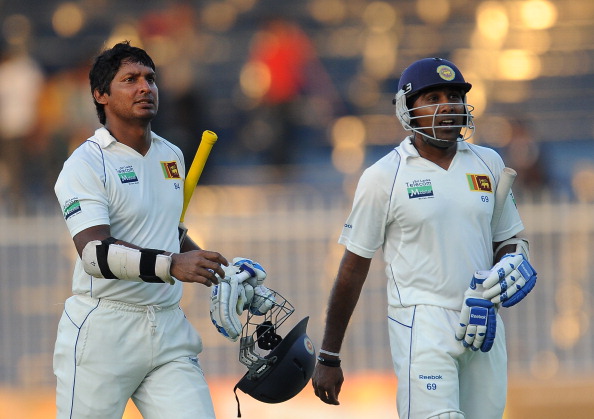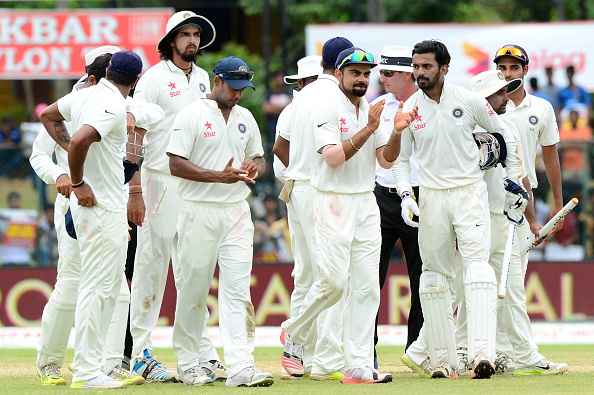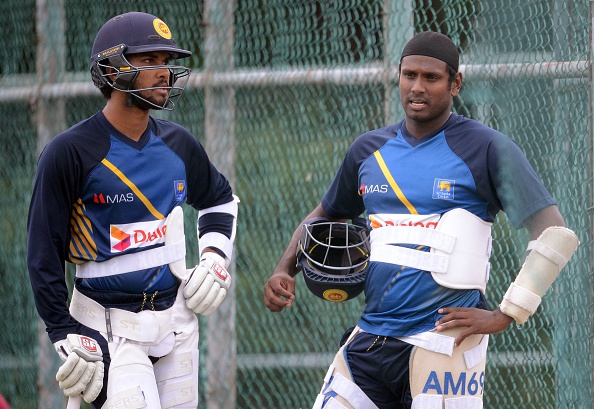
Stats: Sri Lanka's batting struggles since the retirement of stalwarts Kumar Sangakkara and Mahela Jayawardene

Sri Lanka have just been whitewashed by South Africa and they average less than 20 (18.8 to be specific) with the bat this time. As scraping the bottom goes, this is probably the nadir of Sri Lankan batting.
Since the departure of their two batting greats – Mahela Jayawardene (retired in August 2014) and Kumar Sangakkara (retired in August 2015) – the islanders have found it hard to come to terms with Test batting, especially away from home.
Also Read: The new Sri Lankan nucleus: Kusal Perera, Kusal Mendis and Dilruwan Perera
A whitewash of Australia – more a sign of how bad Australia were rather than how good Sri Lanka were, without taking any credit away from them – is probably the only shining light in Sri Lanka’s near deplorable 18 months.
While it is not rocket science to predict the slump teams go through after losing their long-serving stellar players, it is befuddling that Sri Lanka do not have replacements anywhere in sight. Their bench strength is questionable and very few players have managed to survive the constant chopping and changing.
The results (Since June 2015)
At home
Lost 1-2 to Pakistan
Lost 1-2 to India
Won 2-0 against West Indies
Won 3-0 against Australia
Away
Lost 0-2 against New Zealand
Lost 0-2 against England
Won 2-0 against Zimbabwe
Lost 0-3 against South Africa
While Sri Lanka have won at home against Australia (3-0) and West Indies (2-0) and away against Zimbabwe (2-0), the series that will particularly hurt are the ones against India and Pakistan at home. Sri Lanka has a proud record at home but losing two series to two sub-continental teams, 1-2 each time would have hurt.

Add to that the loss to South Africa 0-3 away from home, to England 0-2 away and New Zealand, 0-2, all within the span of thirteen months shows the lack of quality batsmen who can survive in conditions away from home. Three whitewashes away from home in just over a year is as bad as it could get for a side that prides itself in being a cricketing powerhouse.
Batting averages
In 256 Tests, Sri Lanka have a batting average of 32.82, with a W/L ratio of 0.842. Since January 2015 (last 2 years), their batting average has dropped to 27.02 and during this time, Sri Lanka has won 9 and lost 11 Tests. During the same period, only West Indies and Zimbabwe have a batting average lower than that of Sri Lanka.
India and Australia have batting averages over 40 while New Zealand, Bangladesh and Pakistan are close to each other with batting averages of 35.17, 34.40 and 34.38 respectively.
Over a 5-year period from 14 Jan 2012 to 14 Jan 2017, Sri Lanka averages 31.78, the numbers brought down by their dismal performance with the bat in the last couple of years.
Some important numbers between Jan 2010 – December 2014 throws further light:
Sri Lanka average 35.99 with the bat overall
Sri Lanka average 38.29 at home
Sri Lanka average an impressive 33.94 away from home
Between Jan 2015 to 14 Jan 2017:
Sri Lanka average 27.05 overall with the bat
Sri Lanka average 28.02 at home, only marginally higher than their overall average
Sri Lanka average 26.11 away from home in 22 innings, losing 8 and winning just 2 Tests
Top Order Partnerships
Sri Lanka have had some really good partnerships between 2010 and 2015. In the last couple of years, they have relied heavily on players like Kaushal Silva and Dimuth Karunaratne along with veterans Dinesh Chandimal and Angelo Mathews.
Players like Upul Tharanga, Lahiru Thirimanne, and B Mendis have been in and out leaving Sri Lanka without too many reliable players.
6-year period
Between Jan 2010 and Dec 2015 (6-year period) Sri Lanka’s top-order partnerships (1-6) have averaged 37.41 in UAE (2011/12) and 49.66 in 2013/14, 32.52 in Australia (2012/13), 32.94 in South Africa (2011/12), 40 in England (2011) and then 45.79 (in 2014) and 66.28 at home against India (2010).
2-year period
Compare that to their averages since Jan 2015 and see that Sri Lanka’s partnerships from 1 to 6 have hit a high of 51.29 against Zimbabwe. They averaged 41.11 against West Indies at home. In all other Test series, home and away, Sri Lankan top 6 averaged below 40 and below 35 in all but one occasion.

Sri Lanka have only three pairs (up to 6th wicket) which have added over 400 runs since Jan 2015. More importantly, only 7 pairs have averaged over 50. Between Jan 2010 and Dec 2015, they had 14. It helped that Sangakkara and Jayawardene figured in a lot of those partnerships.
Overall century and half-century partnerships
Since Jan 2015, Sri Lanka have had 16 century partnerships and 48 half-century partnerships. 7 of those century partnerships and 22 half-century partnerships came playing away. The highest from one pair is 2 (Chandimal and Karunaratne and Karunaratne and Kaushal Silva).
Since Jan 2016, Sri Lanka have 7 century and 25 half-century partnerships across 207 partnership innings. More importantly, the partnership averages have been above 40 only for fifth and sixth wickets showing how the top order is failing consistently.
Between Jan 2010 and 31 December 2015, Sri Lanka had 62 century and 130 half-century partnerships, across 883 partnership innings, a much higher average of century and half-century partnerships per year as well as per partnership innings.
The most striking aspect of this period is that the partnership average for second, third, fourth, fifth and sixth is above 40. For the opening wicket, it is 35. That explains why Sri Lanka did better while their middle order was beefed up by stalwarts like Sanga and Mahela
While numbers can be bent, and twisted in a million ways, few things are obvious:
Sri Lanka’s overall batting averages have dipped in the last couple of years drastically
Sri Lanka’s top-order contributions have dipped in the last couple of years
The average number of century and half-century partnerships have dipped in the last couple of years.
The average partnership was over 40 for 2nd – 6th wicket from 2010 to 2015 while it is above 40 only for 5th and 6th wickets since 2016 showing how Sri Lankan lower order is always dealing with a crisis.
All stats courtesy of ESPNcricinfo